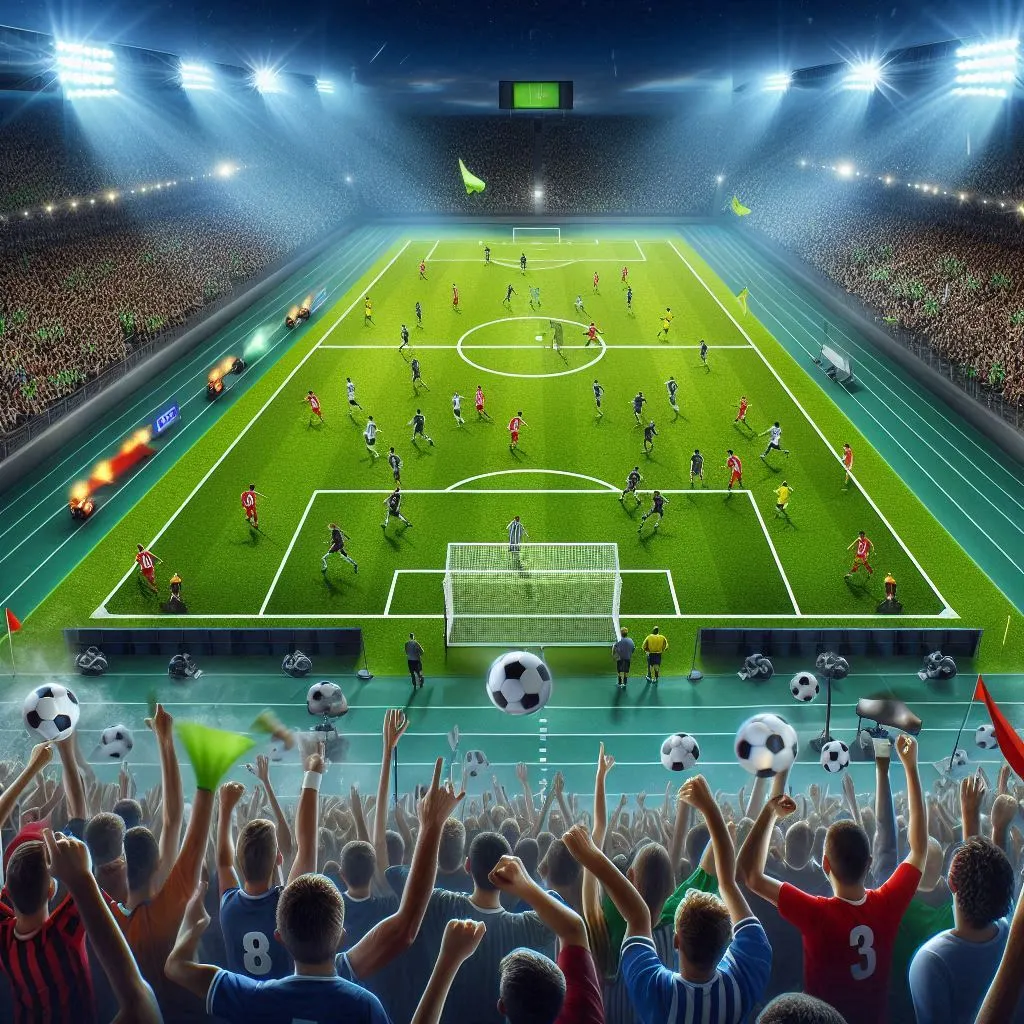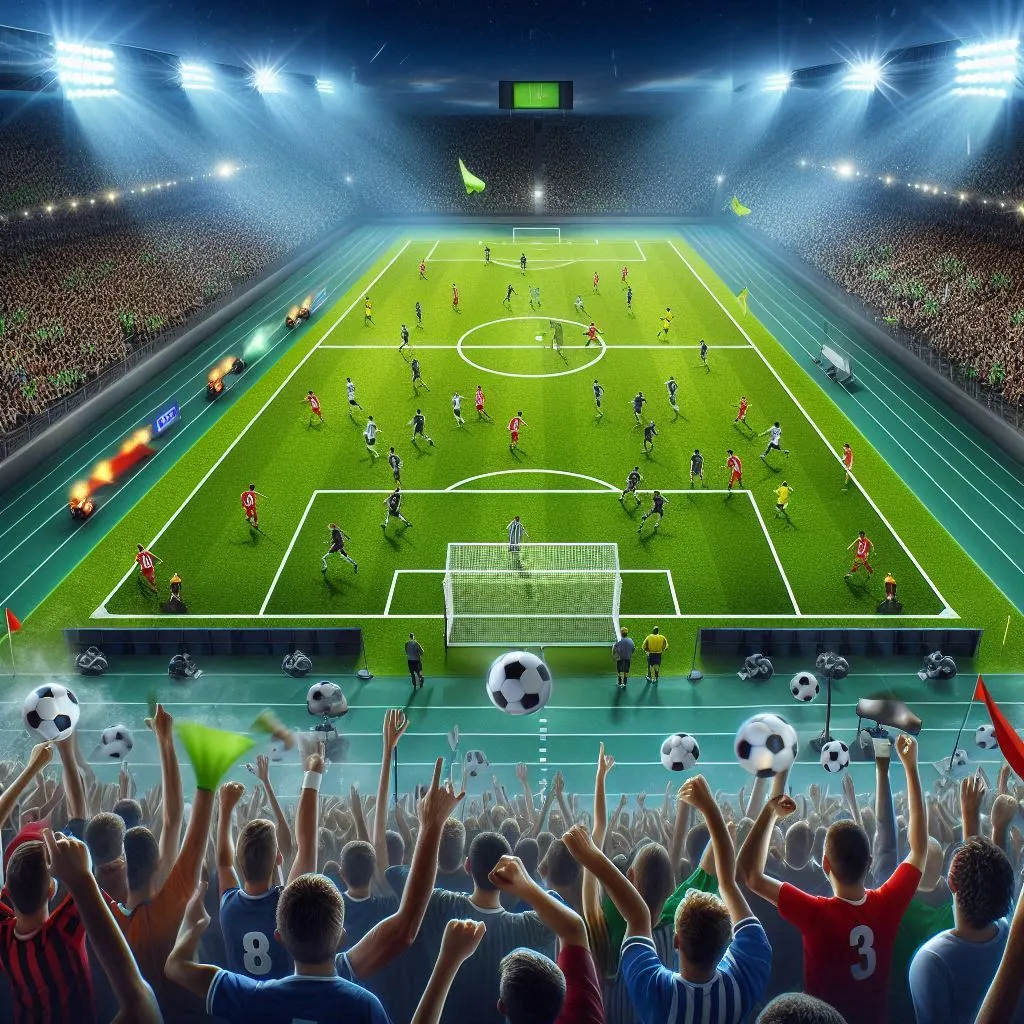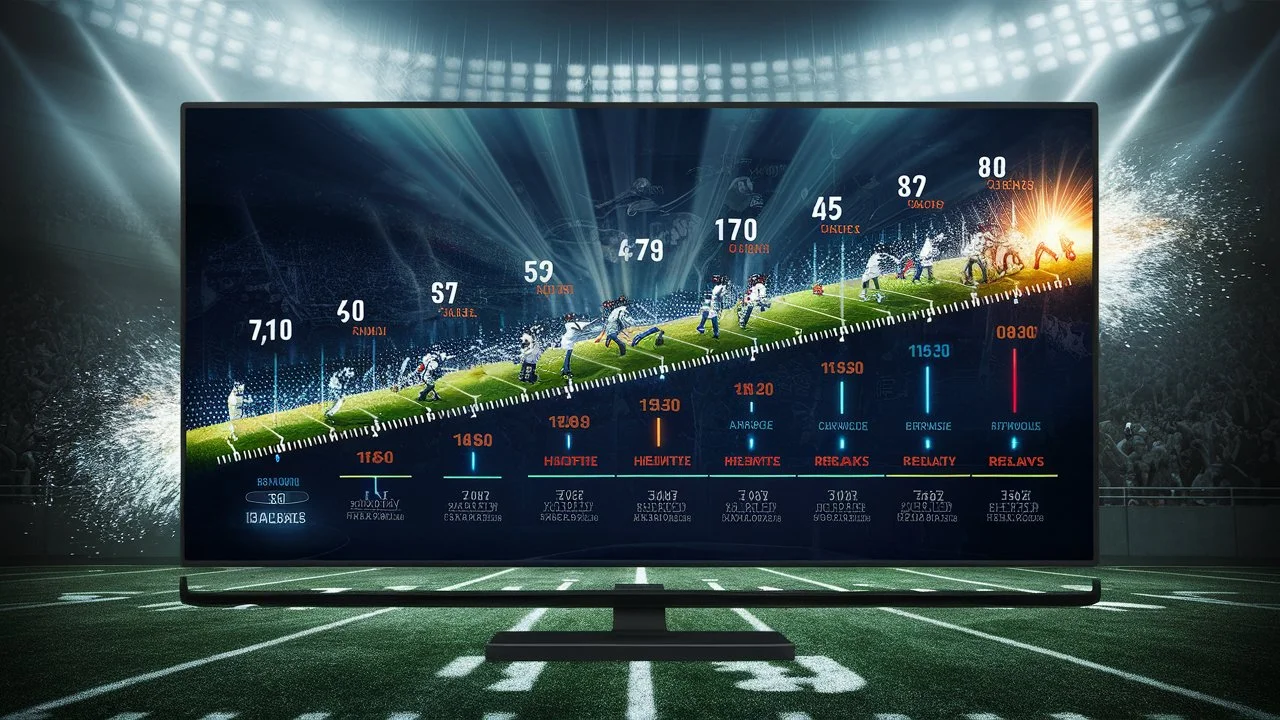Watching a football game on TV is a cherished pastime for many sports enthusiasts around the world. Knowing how long these games last can help fans plan their schedules and enjoy the experience without missing a moment. This article will break down the timeline of a football game, covering every aspect from the standard game duration to commercial breaks and post-game analysis.
Understanding the average length of a football game on TV involves several components:
- The standard 90-minute game duration
- Additional time such as injury time and extra time
- Pre-game and post-game shows that add to the total viewing time
Whether you’re a die-hard football fan or a casual viewer, knowing how long a football game lasts on TV can enhance your viewing experience. In this comprehensive guide, we’ll explore every detail, including the impact of commercial breaks, the role of half-time shows, and how delays and interruptions can extend the game. By the end of this article, you’ll have a clear understanding of the football game duration and what to expect when tuning in to watch your favorite teams play.
In the following sections, we’ll delve into the specifics of each component, providing a detailed breakdown of the football match length on TV. This includes:
- The standard football game duration and how it’s structured
- The influence of pre-game and post-game coverage
- The impact of additional time and commercial breaks on the overall football game duration
Stay tuned to learn everything you need to know about how long football games last on TV and make the most out of your viewing experience.
Standard Duration of a Football Game

A football game typically lasts 90 minutes, split into two 45-minute halves. This is the standard duration for most football matches worldwide. Understanding this basic structure helps in planning your viewing time effectively.
Standard 90-Minute Game
- Two 45-minute halves: The game is divided into two halves of 45 minutes each. The referee’s whistle signals the start and end of each half.
- Half-time break: There is a 15-minute break between the two halves, giving players time to rest and strategize. For viewers, this is often a chance to grab a snack or stretch.
This structure ensures that a regular football match, without any additional time, will be approximately 105 minutes long, including the half-time break.
Historical Context
- Origins of the 90-minute duration: The 90-minute game length has been a standard since the early days of football. It was established to ensure a balance between a game’s intensity and players’ endurance.
- Why 45-minute halves?: The division into two halves allows for a mid-game break, providing a strategic pause for both teams and keeping the game dynamic.
The 90-minute duration is a cornerstone of football, making it predictable and easy for fans to schedule their viewing around it.
Half-Time Break
- Purpose: The 15-minute half-time break is crucial for player recovery and tactical adjustments. For viewers, it often features entertainment, advertisements, and analysis.
- Viewer experience: During half-time, broadcasters typically show highlights, expert analysis, and sometimes even entertaining segments to keep the audience engaged.
The half-time break adds an essential pause to the game, making the overall viewing experience more enjoyable and giving viewers time to relax.
Additional Time Elements
While the standard duration is 90 minutes, various elements can extend the length of a football game:
- Injury time (stoppage time): Added at the end of each half to compensate for time lost due to injuries or other interruptions.
- Extra time: Used in knockout stage matches that end in a draw, consisting of two 15-minute halves.
- Penalty shootouts: Conducted if the match remains tied after extra time, determining the winner.
These additional time elements ensure fairness and a decisive outcome, though they can significantly extend the game’s duration.
Understanding the standard duration of a football game is essential for planning your viewing experience. The typical 90-minute game, combined with the half-time break, makes for an engaging and predictable event. However, be prepared for possible extensions due to injury time, extra time, or penalty shootouts, which can add to the overall football match length on TV.
Additional Time
Football games often extend beyond the standard 90 minutes due to various factors. These extensions ensure the game is fair and complete, even if it means viewers need to adjust their schedules. Understanding these additional time components is crucial for a full grasp of the football match length.
Injury Time (Stoppage Time)
- Definition: Injury time, also known as stoppage time, is added at the end of each half to make up for time lost due to injuries, substitutions, and other delays.
- Calculation: The referee decides the amount of injury time, usually ranging from 1 to 5 minutes per half. This time is added to ensure that the game is fair and that no team benefits unfairly from time-wasting or other delays.
- Examples: In many matches, you might see 2-3 minutes added to the first half and 4-5 minutes to the second half. This can slightly extend the overall viewing time.
Injury time ensures the game remains fair, but it can add a few minutes to the football game duration.
Extra Time
- Definition: Extra time is played when a knockout stage match ends in a draw after the regular 90 minutes. It consists of two 15-minute halves, making an additional 30 minutes.
- Scenarios: This is common in tournaments like the World Cup, Champions League, and domestic cup competitions where a winner must be determined.
- Structure: Each half of extra time is 15 minutes long, with a brief break in between but no additional half-time.
Extra time can add significant length to the game, turning a 90-minute match into a 120-minute spectacle, especially in high-stakes games.
Penalty Shootouts
- Definition: If the match remains tied after extra time, it proceeds to a penalty shootout to determine the winner.
- Process: Each team takes five penalty shots, and the team with the most goals wins. If the score is still tied, it goes to sudden death until a winner is decided.
- Duration: While the actual penalty kicks are quick, the preparation and execution can add an additional 10-15 minutes to the game.
Penalty shootouts are thrilling and decisive, but they also extend the total football match length on TV.
Impact on Viewing Experience
- Uncertainty: The potential for injury time, extra time, and penalty shootouts adds an element of unpredictability to the viewing experience. Fans need to be prepared for the game to run longer than the scheduled 90 minutes.
- Excitement: These additional time periods often bring the most excitement and drama, making them worth the wait for many viewers.
- Planning: Understanding these elements helps viewers plan better, ensuring they can catch the thrilling conclusion without missing any action.
The additional time components are crucial for ensuring fairness and providing a conclusive result in football matches. While they can extend the football game duration, they also add to the excitement and unpredictability that makes football such a beloved sport. By accounting for injury time, extra time, and potential penalty shootouts, viewers can better plan their schedules and fully enjoy the football experience on TV.
Pre-Game Coverage

Before the main event of a football match kicks off, extensive pre-game coverage is provided to build anticipation and inform viewers. This segment plays a significant role in extending the total football game duration on TV, as it includes various elements that prepare the audience for the game.
Overview of Pre-Game Shows
- Content: Pre-game coverage typically includes team news, player interviews, tactical analysis, and expert opinions. Broadcasters aim to offer comprehensive insights into the upcoming match, helping viewers understand team strategies and key players.
- Duration: Pre-game shows usually start 30 to 60 minutes before the scheduled kick-off time. This time allows for in-depth discussions and coverage, setting the stage for the match.
Pre-game coverage is designed to engage viewers and provide valuable context, making the entire football viewing experience richer and more enjoyable.
Team News and Analysis
- Team News: Broadcasters provide updates on player injuries, team line-ups, and last-minute changes. This information is crucial for fans who want to know which players will be on the field.
- Tactical Analysis: Experts break down the tactical approaches of both teams, discussing formations, key match-ups, and potential game strategies. This analysis helps viewers understand the game’s strategic aspects.
These elements help set the expectations and excitement for the game, adding to the overall pre-game viewing experience.
Expert Opinions and Interviews
- Pre-Match Interviews: Interviews with coaches, players, and pundits offer insights into team preparations and mental readiness. These interviews often highlight personal stories and player motivations.
- Expert Opinions: Analysts and former players provide their predictions and opinions on how the game might unfold. These insights can spark discussions among viewers and enhance their engagement.
Expert opinions and interviews contribute to a comprehensive understanding of the game, enriching the viewing experience.
Impact on Viewing Time
- Extended Viewing Time: With pre-game coverage typically lasting up to an hour, the total duration for watching a football match on TV can extend significantly. This additional time should be factored into your schedule if you plan to watch the entire broadcast.
- Viewer Engagement: While the pre-game segment adds extra time, it also increases viewer engagement by providing valuable context and enhancing the overall experience.
Pre-game coverage is a key component of football broadcasts, adding depth and context to the viewing experience. While it extends the total football game duration on TV, it also enriches the content and builds excitement for the match. By understanding the importance and length of pre-game coverage, viewers can better plan their schedules and fully enjoy the entire football experience.
mini
Post-Game Coverage

After the final whistle, the excitement of a football game continues with extensive post-game coverage. This segment is crucial for wrapping up the day’s events and providing viewers with a comprehensive analysis of the match. Post-game coverage can add significant time to the overall football game duration on TV, enhancing the viewing experience.
Summary of Post-Game Analysis
- Highlights and Recaps: Post-game coverage typically includes highlights of key moments from the match. This segment shows crucial goals, key saves, and notable plays, allowing viewers to relive the most exciting parts of the game.
- Expert Analysis: Analysts and commentators provide in-depth reviews of the game, discussing key performances, tactical decisions, and turning points. This analysis helps viewers understand the game’s nuances and what influenced the outcome.
The detailed post-game analysis offers valuable insights and allows fans to digest and reflect on the match.
Player Interviews and Reactions
- Post-Match Interviews: Interviews with players and coaches provide personal reactions and reflections on the game. These interviews often reveal emotions, strategies, and thoughts that are not visible during the match itself.
- Reactions: Players and coaches share their perspectives on the game’s outcome, discussing what went well and what could have been improved. These reactions add a personal touch to the post-game coverage.
Player interviews and reactions offer a deeper connection to the game, making the viewing experience more engaging and informative.
Post-Game Shows
- Content: Post-game shows often feature extended discussions, including debates among pundits, fan reactions, and further analysis of the game’s key moments. These shows aim to provide a comprehensive wrap-up of the day’s events.
- Duration: Post-game coverage can last 30 to 60 minutes, depending on the significance of the match and the depth of analysis provided.
Post-game shows help viewers process and discuss the game, extending the total duration of the football broadcast on TV.
Impact on Total Viewing Time
- Extended Duration: With post-game coverage lasting up to an hour, the overall time spent watching football can extend well beyond the match itself. This extra time should be considered when planning to watch the entire broadcast.
- Enhanced Experience: While post-game coverage adds extra time, it also enhances the overall viewing experience by providing a thorough analysis and personal insights into the game.
Post-game coverage is a key element of football broadcasts, offering detailed analysis, player reactions, and extended discussions. Although it extends the total football game duration on TV, it enriches the viewing experience by providing valuable context and insights into the match. By including post-game coverage, viewers can fully appreciate and reflect on the game’s events.
mini
Commercial Breaks

Commercial breaks are a significant aspect of football broadcasts, influencing both the viewing experience and the overall football game duration on TV. They provide broadcasters with a means to generate revenue while offering viewers a break from the action. Understanding how commercial breaks fit into the football viewing experience can help you better plan your time.
Frequency and Duration
- Breaks During the Game: Football games typically include commercial breaks during specific moments. These include breaks at half-time and possibly a few short breaks during the first and second halves.
- Duration: Each commercial break usually lasts between 2 to 3 minutes. The frequency of these breaks can vary depending on the broadcaster and the country.
Commercial breaks are strategically placed to minimize disruption while maximizing advertising opportunities.
Impact on Viewing Time
- Extended Viewing Time: The addition of commercial breaks extends the total duration of a football broadcast. While the actual game lasts 90 minutes, commercials can add an extra 10 to 15 minutes to the total viewing time.
- Viewer Experience: While commercials are a necessary part of TV broadcasting, they can disrupt the viewing experience. However, they also provide viewers with brief intervals to catch up on social media, grab refreshments, or take a quick break.
Understanding the impact of commercial breaks helps viewers plan their time more effectively and manage expectations regarding the total length of the broadcast.
Strategies for Managing Commercial Breaks
- Multitasking: Use commercial breaks to catch up on social media, make snacks, or do other activities. This helps make the most of the downtime without missing any game action.
- Timing: Keep track of the game’s progress and anticipate commercial breaks. This allows you to manage your time better and return to the action promptly.
By managing commercial breaks effectively, viewers can enhance their football-watching experience while minimizing interruptions.
Broadcast Strategies
- Placement: Broadcasters aim to place commercial breaks during natural pauses in the game, such as after goals or substitutions. This minimizes disruption and ensures that viewers do not miss critical moments.
- Content: During commercial breaks, broadcasters often air promotional content, replays, and other engaging material to keep viewers entertained and engaged.
Commercial breaks play a crucial role in football broadcasts, extending the total football game duration on TV while providing essential revenue for broadcasters. By understanding their impact and managing them effectively, viewers can improve their overall viewing experience and ensure they enjoy the full football experience without unnecessary interruptions.
mini
Special Events and Variations
Football broadcasts can vary significantly depending on the type of game or competition, influencing the overall football game duration on TV. Special events and variations, such as international tournaments or domestic cup matches, often have unique formats and additional segments that extend the total viewing time.
International Tournaments
- World Cup and Euro Cup: International tournaments like the FIFA World Cup and UEFA European Championship feature group stages, knockout rounds, and finals. Each stage may have different broadcasting formats, including extended pre-game and post-game coverage.
- Extended Coverage: These tournaments often include additional features such as team introductions, ceremonial events, and fan interactions, which can add extra time to the broadcast.
International tournaments offer a more extensive viewing experience, with extended coverage and special segments that enhance the overall duration of football broadcasts.
Domestic Leagues
- League Matches: Domestic leagues such as the Premier League, La Liga, and Serie A typically follow a standard format, but some matches may feature additional coverage, such as build-up to high-profile games or special reports.
- Special Broadcasts: Matches involving popular teams or significant fixtures may have extended pre-game and post-game coverage, including interviews and in-depth analysis, which can lengthen the total viewing time.
Domestic league matches provide a consistent viewing experience but may vary in length depending on the importance of the game and the coverage provided.
Cup Competitions
- Knockout Stages: Cup competitions like the FA Cup and Champions League often include knockout stages where matches may go to extra time and penalties if tied. This adds to the overall game duration.
- Finals and Semifinals: High-stakes matches such as finals and semifinals typically have extended coverage, including special features, historical highlights, and in-depth analysis.
Cup competitions introduce additional elements such as extra time and penalty shootouts, contributing to a longer total viewing time for fans.
Variations in Coverage
- Regional Differences: Broadcasting formats and durations can vary based on the region or country. Some regions may offer more extensive coverage, while others may have more concise broadcasts.
- Special Features: Certain broadcasts may include unique segments like behind-the-scenes footage, fan interactions, and live updates from the stadium, all of which can extend the overall viewing time.
Special events and variations in football broadcasts provide a richer and more diverse viewing experience, though they often extend the total football game duration on TV. By understanding these differences, viewers can better prepare for and enjoy the additional content and extended coverage associated with major football events and competitions.
Delays and Interruptions
Football games can be interrupted or delayed for various reasons, affecting the overall football game duration on TV. These delays can range from weather conditions to technical issues and even crowd disturbances. Understanding these potential interruptions helps viewers better plan their viewing time and manage expectations.
Weather Conditions
- Rain and Snow: Adverse weather conditions, such as heavy rain or snow, can lead to delays or temporary suspensions of a football match. In severe cases, matches may be postponed or rescheduled.
- Impact on Viewing Time: Weather-related delays can extend the duration of a football game significantly. The broadcast may include updates and coverage of the delay until the match resumes.
Weather conditions can cause unpredictable delays, making it essential for viewers to be prepared for potential interruptions in the broadcast.
Technical Issues
- Broadcast Problems: Technical issues such as signal loss, equipment failure, or broadcasting errors can lead to interruptions in the broadcast. These issues may require time to resolve, extending the total viewing time.
- Resolution: Broadcasters often provide updates and alternative content during technical difficulties, keeping viewers informed while issues are addressed.
Technical problems can disrupt the viewing experience and extend the length of the broadcast until the issues are resolved.
Crowd Disturbances
- Field Incidents: Occasionally, incidents involving spectators, such as pitch invasions or crowd disturbances, can halt the game. These situations require time to manage and resolve, affecting the game’s duration.
- Safety Protocols: Referees and security personnel work to ensure safety and restore order, which can lead to extended stoppage time or delays.
Crowd disturbances, while rare, can significantly impact the overall duration of a football match and extend the time viewers spend watching the broadcast.
Impact on Viewing Experience
- Uncertainty: Delays and interruptions introduce uncertainty into the viewing experience. Fans may need to adjust their plans and be prepared for the game to run longer than initially scheduled.
- Extended Coverage: Broadcasters typically provide updates and coverage during delays, which can add additional time to the total broadcast duration.
Understanding the potential for delays and interruptions helps viewers manage their expectations and plan accordingly. While these factors can extend the football game duration, they are part of the broader viewing experience, and broadcasters strive to keep audiences informed and entertained during such events.
Half-Time Shows
Half-time shows are a prominent feature of football broadcasts, especially in major leagues and tournaments. They add entertainment and analysis between the two halves of the match, contributing to the overall football game duration on TV. Here’s a closer look at what half-time shows involve and their impact on the viewing experience.
Entertainment Segments
- Musical Performances: Half-time shows often feature live musical performances by popular artists or bands. These performances are designed to entertain viewers and provide a break from the football action.
- Special Acts: Some half-time shows include special acts such as dance performances, acrobats, or other forms of entertainment. These acts aim to keep the audience engaged and add an extra layer of excitement to the broadcast.
Entertainment segments during half-time offer a chance for viewers to enjoy diverse content beyond the football match.
Analysis and Commentary
- Expert Analysis: During the half-time break, broadcasters typically provide expert analysis of the first half of the game. Analysts discuss key moments, player performances, and tactical adjustments.
- Replays and Highlights: Key moments from the first half, including goals, saves, and controversial decisions, are replayed and discussed. This analysis helps viewers gain a deeper understanding of the game.
Analysis and commentary during half-time enhance the viewing experience by providing insights and context about the match.
Fan Engagement
- Interactive Content: Some half-time shows include interactive segments where fans can participate through social media or live polls. This engagement helps maintain interest and excitement throughout the broadcast.
- Fan Reactions: Broadcasters often feature reactions from fans in the stadium or from around the world. These segments add a personal touch and showcase the passion of the football community.
Fan engagement during half-time adds a dynamic element to the broadcast, making it more interactive and enjoyable.
Impact on Total Viewing Time
- Extended Duration: Half-time shows typically last 15 to 20 minutes, extending the total football game duration on TV. This additional time should be considered when planning your viewing schedule.
- Enhanced Experience: While half-time shows add extra time, they also provide valuable entertainment and analysis, enriching the overall viewing experience.
Half-time shows are an integral part of football broadcasts, offering a mix of entertainment, analysis, and fan engagement. Although they extend the total football game duration, they contribute to a more enjoyable and comprehensive viewing experience. By including half-time shows, broadcasters aim to keep viewers entertained and informed, making the football experience more dynamic and engaging.
Extra Features and Broadcast Variations
Football broadcasts can include a range of extra features and broadcast variations that contribute to the total football game duration on TV. These elements provide additional context, engagement, and coverage, enhancing the overall viewing experience.
In-Stadium Features
- Live Updates: In-stadium features often include live updates and interviews with fans and officials. These updates provide real-time insights and add to the broadcast’s dynamism.
- Fan Cam: Many broadcasts include “Fan Cam” segments, showcasing reactions and interactions from fans in the stadium. This adds a personal and lively dimension to the coverage.
In-stadium features enhance the viewing experience by bringing viewers closer to the atmosphere and excitement of the live event.
Enhanced Graphics and Stats
- On-Screen Graphics: Modern broadcasts frequently use advanced graphics to display statistics, player information, and tactical analysis. These graphics provide viewers with a richer understanding of the game.
- Live Stats: Real-time statistics, such as possession percentages, player ratings, and team performance metrics, are often displayed. These features keep viewers informed and engaged.
Enhanced graphics and stats offer viewers a detailed and interactive viewing experience, contributing to a more comprehensive broadcast.
Post-Match Analysis and Features
- Extended Analysis: After the match, extended analysis segments delve deeper into key moments, including tactical reviews and player performances. These segments often feature expert opinions and detailed breakdowns.
- Feature Stories: Broadcasts may include feature stories about players, teams, or significant moments from the game. These stories add context and background, enriching the overall coverage.
Post-match analysis and features provide a thorough wrap-up of the game, adding valuable content and extending the total viewing time.
Broadcast Variations
- International Broadcasts: Different countries and broadcasters may offer varied coverage, including additional features, interviews, or alternative angles. This can affect the total broadcast length.
- Special Editions: Some broadcasts include special editions with behind-the-scenes footage, historical highlights, or in-depth documentaries related to the game or tournament.
Broadcast variations and extra features contribute to the overall duration of the football broadcast, offering a richer and more engaging viewing experience. By incorporating these elements, broadcasters aim to provide comprehensive coverage and enhance viewer satisfaction.
Understanding these additional features helps viewers appreciate the extended content and plan their viewing time accordingly. Whether through in-stadium updates, advanced graphics, or post-match analysis, these elements contribute to a fuller, more enjoyable football experience on TV.
Summary and Key Takeaways
In summary, understanding the various factors that influence the football game duration on TV can help viewers better plan their watching experience. From pre-game and post-game coverage to commercial breaks and special events, each element contributes to the overall length of a football broadcast.
Key Points
- Pre-Game and Post-Game Coverage: Both segments provide valuable context and analysis, extending the total viewing time. Pre-game coverage includes team news and expert opinions, while post-game coverage offers highlights, player reactions, and in-depth analysis.
- Commercial Breaks: These are necessary for broadcasting revenue but can add 10 to 15 minutes to the total duration of the broadcast. Managing commercial breaks effectively can enhance the viewing experience.
- Special Events and Variations: Major tournaments, domestic leagues, and cup competitions often feature additional coverage and extended formats. These events can introduce extra time due to special features and extended segments.
- Delays and Interruptions: Weather conditions, technical issues, and crowd disturbances can all lead to delays, affecting the overall duration of the broadcast. Being prepared for these uncertainties can help manage expectations.
- Half-Time Shows: These provide entertainment and analysis, adding 15 to 20 minutes to the total viewing time. Half-time shows are designed to keep viewers engaged and offer a break from the action.
- Extra Features: Enhanced graphics, in-stadium updates, and extended analysis contribute additional content to the broadcast, enriching the viewing experience.
Planning Your Viewing
To make the most of your football watching experience:
- Check Schedule: Be aware of the start time and estimated end time, including additional segments such as pre-game and post-game coverage.
- Prepare for Delays: Allow for potential delays or interruptions that might extend the total broadcast time.
- Engage During Breaks: Use commercial breaks and half-time shows to catch up on social media, grab refreshments, or take a break.
By understanding these factors, you can better plan your football viewing time and ensure a more enjoyable and comprehensive experience. Whether it’s enjoying pre-game insights, analyzing post-match highlights, or navigating commercial breaks, being informed about the total duration helps maximize your football-watching pleasure.
Conclusion
Understanding the football game duration on TV involves more than just knowing the match’s 90 minutes. Various elements contribute to the total time spent watching, each adding a unique layer to the football viewing experience.
Recap of Key Elements
- Pre-Game and Post-Game Coverage: These segments are essential for in-depth analysis and context, extending the viewing time before and after the match.
- Commercial Breaks: Necessary for broadcasting revenue, commercial breaks can add additional minutes to the total viewing time, which viewers should anticipate.
- Special Events and Variations: Major tournaments, domestic leagues, and cup competitions often include extra features and extended segments, influencing the overall broadcast length.
- Delays and Interruptions: Weather, technical issues, and crowd disturbances can cause unpredictable delays, affecting the match duration.
- Half-Time Shows: Providing entertainment and analysis, half-time shows contribute to the total viewing time, making the experience more engaging.
- Extra Features: Enhanced graphics, live updates, and post-match features add valuable content and extend the broadcast.
Maximizing Your Viewing Experience
To fully enjoy a football broadcast:
- Be Prepared: Check the schedule and anticipate additional coverage and commercial breaks. This preparation helps you manage your time effectively.
- Engage with the Content: Use half-time and commercial breaks to catch up on related content, engage with fan communities, or take a brief respite.
- Adapt to Variations: Be flexible and ready for any unexpected delays or extended segments, especially during special events or major tournaments.
By considering these factors, you can ensure a more enjoyable and comprehensive football-watching experience. Each element, from pre-game analysis to post-match highlights, adds to the richness of the broadcast. Understanding how these components impact the football game duration helps you plan your viewing time and fully appreciate the excitement and depth of the sport.

Ethan Richards is a dedicated sports writer who excels in delivering timely and accurate sports news. His meticulous research and clear, concise writing make his articles both informative and enjoyable. Ethan’s commitment to quality journalism sets him apart in the industry.











